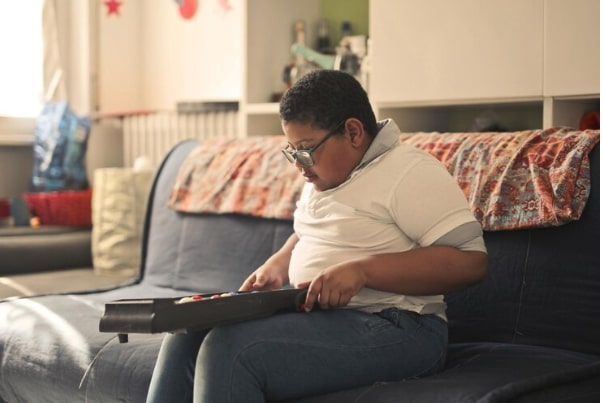How to deal with childhood obesity?

Obesity is defined as youngsters having a BMI equal to or more than 95 percent of their peers. BMI is a metric used to assess your “weight status.” Your BMI is calculated based on your height and weight. Using your gender and age, your BMI percentile (where your BMI value sits in proportion to other people) is calculated.
Obesity is a severe health risk for children. Obese children are more than just overweight; they are at risk for a variety of chronic health issues. Obesity-related health problems can persist throughout maturity.
In India, childhood obesity has become an epidemic. India has the world’s second-highest population of obese children, with 14.4 million, after only China. In youngsters, the prevalence of overweight and obesity is 15%. The prevalence has risen to 35-40% in private schools catering to upper-income households, showing a concerning growing trend.
Major causative factors of childhood obesity:
A child may be fat for a variety of reasons, including medical or hereditary factors. Most youngsters are overweight because they eat unhealthy meals and live a sedentary lifestyle. If you suspect your child is overweight due to a medical ailment, see your pediatrician, who can run tests to confirm it.
The following are some of the reasons why an increasing number of children are getting obese:
Behavioral factors:
Eating larger amounts, consuming meals that are high in calories but low in nutrients (junk foods), spending excessive time in front of the television or computer, and spending insufficient time undertaking physical activities
Environmental factors:
Lack of parks and playgrounds in some neighborhoods, easy availability to high-calorie junk foods, few opportunities for physical activity
Medical conditions:
Obesity can be caused by medical illnesses such as Prader-Willi syndrome and hormonal abnormalities like hypothyroidism.
How is the risk of obesity in a child determined?
Your best pediatric endocrinologist may use a variety of measures to evaluate if your child is at risk for obesity, including:
- Yearly tracking of your child’s BMI percentile to see if there is a sudden spike
- Recognising newborns that gain too much weight in infancy; research reveal that these babies are at danger of becoming overweight as they grow older
- Birth weight and gestational diabetes may raise a child’s risk of obesity and type 2 diabetes later in life.
- Obesity, type 2 diabetes, hyperlipidemia, hypertension, sleep apnea, and an early heart attack in the family: these variables can also place a child at risk for obesity and its accompanying medical consequences.
Significant signs that might help indicate childhood obesity:
Obesity in children is typically characterized by excess body weight in addition to the following symptoms:
- Shortness of breath
- Fatigue
- Increased sweating
- Sleep apnea and snoring
- Joint pain
- Dislocated hips
- Flat feet and knock knees
- Skin rashes and irritation
- stretch marks on the back, stomach, and hips (though these can occur in non-obese children as well)
- Dark, velvety skin around the neck and in other places is a sign of a condition called acanthosis nigricans.
- Constipation
- Gastroesophageal reflux (also called acid reflux)
- Early puberty in girls
- Delayed puberty in boys
What complications can arise if childhood obesity is not treated?
Childhood obesity is frequently associated with issues in a child’s physical, social, and emotional well-being.
Type 2 diabetes:
This chronic disease has an impact on how your child’s body processes sugar (glucose). Obesity and sedentary living raise the risk of type 2 diabetes.
High cholesterol and high blood pressure:
Your child may develop one or both of these illnesses as a result of a bad diet. These variables can contribute to plaque development in the arteries, causing them to constrict and stiffen, perhaps leading to a heart attack or stroke later in life.
Joint pain:
Extra weight puts additional strain on the hips and knees. Childhood obesity can result in hip, knee, and back pain, as well as injuries.
Breathing concerns:
Children who are overweight are more likely to get asthma. These youngsters are also more prone to develop obstructive sleep apnea, a potentially fatal disorder in which a child’s breathing stops and starts frequently throughout sleep.
Nonalcoholic fatty liver disease (NAFLD):
This condition causes fatty deposits to accumulate in the liver and normally has no symptoms. Scarring and liver damage can result from NAFLD.
Treatment options that can help dealing childhood obesity:
Childhood obesity treatment differs from treatment of adults. Involving the family in a child’s weight control programme is an important part of the treatment process. Family, as a support system, is critical in achieving weight management goals.
Diet Therapy:
When treating an obese child or adolescent, it is often recommended that they contact with a nutritionist who specialises in children’s requirements. Nutritionists are the ideal people to help youngsters understand healthy eating habits and how to incorporate them into their long-term diet. Reach out to a childhood obesity hospital in case you want your child to undergo obesity treatment.
Physical activity:
Increasing physical exercise is another method of treating childhood obesity. Physical activity is a crucial long-term component for children, as research shows that childhood inactivity is linked to a sedentary adult lifestyle.
Behavior modification:
At a young age, lifestyles and behaviors are formed. Parents and children must be educated and focused on adopting long-term healthy lifestyle choices.
Changing eating habits, increasing physical exercise, learning about the body and how to properly fuel it, joining a support group or extracurricular activity, and creating realistic weight management goals are all ways that children and adolescents can modify their behaviour for healthier outcomes.
Weight-loss surgery:
Adolescents with extreme obesity who have been unable to lose weight with lifestyle changes may be candidates for weight-loss surgery. However, there are dangers and long-term problems, as with any sort of surgery. With your child’s doctor, go over the advantages and disadvantages.
If your child’s weight offers a bigger health danger than the potential risks of surgery, your doctor may consider this procedure. A kid considering weight-loss surgery should consult with a team of pediatric obesity specialist, including an obesity medicine expert, a psychologist, and a dietician.
Weight-loss surgery is not a cure-all, and weight loss is also possible without surgery with a weight-loss program. It does not ensure that a teenager will lose weight or be able to keep it off in the long run. Furthermore, paediatric weight loss surgery does not eliminate the necessity for a nutritious diet and frequent physical activity.
Severe obesity is usually reversible. Anyone who is concerned about obesity or its potential symptoms should seek medical attention. Treatments can help people regulate their weight loss and prevent potentially dangerous problems.




